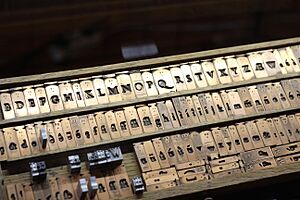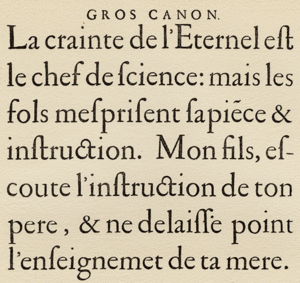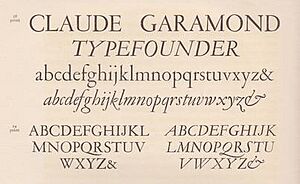Jean Jannon facts for kids
Jean Jannon (died 20 December 1658) was a French printer, type designer, and typefounder who lived in Sedan during the 1600s. He was a Protestant, a branch of Christianity. Jannon was quite busy for his time, printing hundreds of books. He was skilled at creating the metal letters used in printing, known as "type."
Jean Jannon's Career
Jannon started his career as a printer in Paris. He may have worked for the famous Estienne family, who were also printers. He later moved to Sedan. Jannon once wrote that he learned about the early history of printing in Germany, so he might have trained there.
Jean Jannon faced some challenges in Paris. A friend of his, Pierre de L'Estoile, wrote in his diary that Jannon upset some religious leaders because he printed something they didn't approve of. This made Jannon quite unhappy.
After working in Paris, Jannon became the official printer for the Protestant Academy of Sedan. Sedan was a special place at that time, acting like a small, independent area in France. The French government had agreed to let Protestants have some freedoms through an agreement called the Edict of Nantes.
When Jannon was in his thirties, he also started a second job: making the metal punches and molds used to create printing type. In 1640, he moved back to Paris. Even though he was a Protestant, the French royal printing office, called the Imprimerie nationale, bought his metal molds (matrices) in 1641. These molds were for three large sizes of type and are still kept by the government today. Jannon was also very famous for creating an extremely tiny type size, which was called Sédanoise. It was very popular.
In 1640, Jannon left Sedan to take over his son's printing business in Paris, as his son had recently passed away. Four years later, his printing office in Caen was searched by officials. They were worried he might be printing forbidden books. Jannon wasn't put in prison, but he eventually went back to Sedan and stayed there for the rest of his life.
After Jannon died, his printing business in Sedan kept going. His family sold his type foundry (the place where he made type) in 1664.
Jannon's Typefaces
Jannon designed decorative elements for printing, often signing them with his initials, "II." He started making metal type relatively late in his life, in his thirties. In 1621, Jannon wrote about why he began making his own type:
Seeing that for some time many persons have had to do with the art [of printing] who have greatly lowered it…the desire came upon me to try if I might imitate, after some fashion, some one among those who honourably busied themselves with the art…and inasmuch as I could not accomplish this design for lack of types which I needed…[some typefounders] would not, and others could not furnish me with what I lacked [so] I resolved, about six years ago, to turn my hand in good earnest to the making of punches, matrices and moulds for all sorts of characters, for the accommodation both of the public and of myself.
This means he felt that printing quality was going down. He wanted to make his own high-quality type because he couldn't find what he needed from other type makers.
Jannon was one of the few people making printing type in France during the early 1600s. This might have been because of money problems in the country or because there were already enough typefaces available from the century before.
Jannon's typefaces were inspired by the styles from the 1500s. For example, his regular (roman) letters have a unique 'a' with a curved shape. The top-left parts of letters like 'm' and 'p' also have a special scooped-out look. His italic letters are even more unique. They are very slanted, and the capital letters have different slant angles, which makes them stand out.
The Garamond Mix-Up
Even though Jean Jannon had a successful career, he is perhaps most famous for a long-lasting mistake about his work. In 1641, the French royal printing office bought his metal molds (matrices). By the mid-1800s, Jannon's molds were almost the only old printing materials left in Paris from before the 1700s.
Over time, these molds were wrongly thought to belong to Claude Garamond (who died in 1561). Garamond was a very respected type designer from the 1500s. He was known for making type for the government, but that was a century before the royal printing office was even created! The director of the royal printing office, Arthur Christian, became very sure that the molds were Garamond's.
People started to question this idea in 1914 when historian Jean Paillard published his findings. However, he died soon after in World War I, and his work wasn't widely known.
Several early versions of Jannon's type were made and called 'Garamond'. For example, the "Garamond" fonts from American Type Founders (later called Garamond No. 3) and Monotype Garamond (the one often found in Microsoft Office) were actually based on Jannon's designs. Even Frederic Goudy's "Garamont" font was based on Jannon's work.
The mistake was finally proven wrong in 1926 by Beatrice Warde. She wrote under the pen name "Paul Beaujon." She used Paillard's research and found other materials printed by Jannon himself in libraries in London and Paris. She had also been told by an archivist at American Type Founders that he doubted their "Garamond" was truly from the 1500s, as he couldn't find it used in books from that time.
Today, some modern versions of Jannon's type are correctly named after him, like František Štorm's "Jannon Pro" from 2010.
Caractères de l'Université
By the 1800s, Jannon's metal molds became known as the Caractères de l'Université, which means "Characters of the University." No one is completely sure where this name came from. Some people thought it was an official name given by a powerful leader named Cardinal Richelieu.
Beatrice Warde suggested in 1926 that it might be a confused memory of Jannon's work with the Sedan Academy, which was like a university. Other historians have agreed with this idea. However, some believe that the term might have just been a general name in the 1700s for older, more traditional typefaces, perhaps those favored in academic books.
The only remaining copy of Jannon's own sample book of type is kept at the Bibliothèque Mazarine in Paris. Beatrice Warde published a copy of it in 1927.




